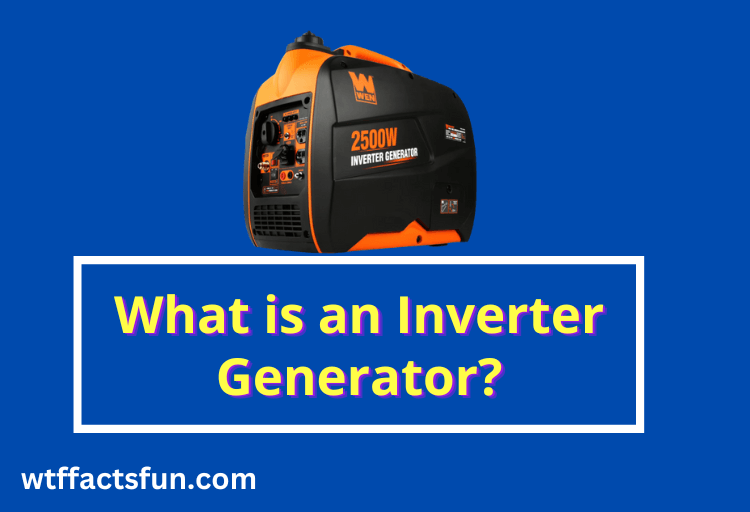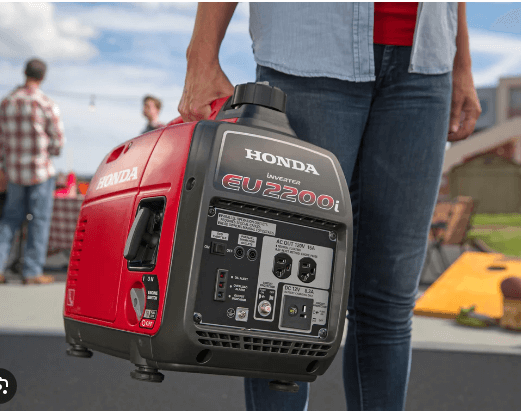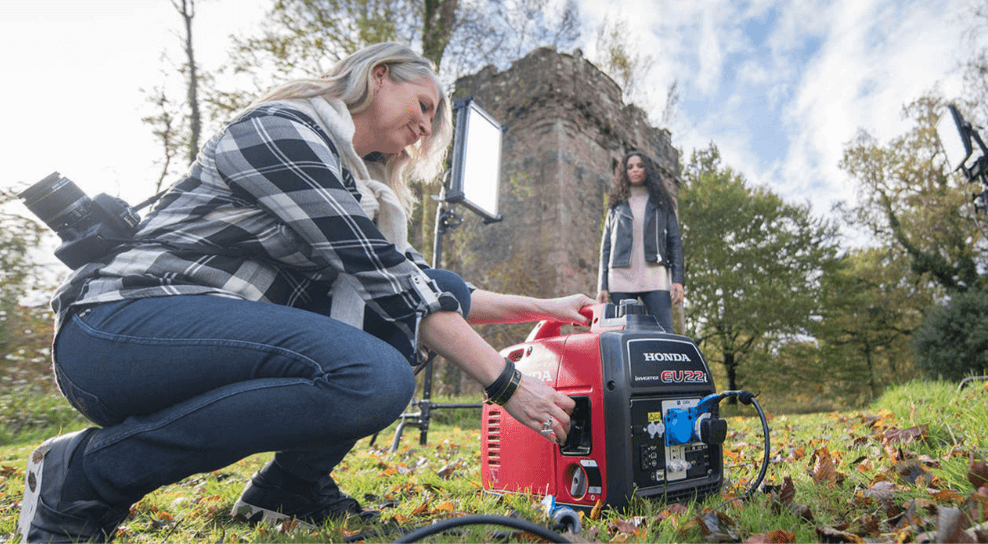
What is an Inverter Generator: An inverter generator is a type of portable power generator that converts DC power into AC power, making it ideal for outdoor activities, camping, and emergency backup power. Inverter generators are known for their efficiency, low noise levels, and stable power output, making them a popular choice for both recreational and professional use.
In this article, we will discuss what an inverter generator is, how it works, and its advantages over traditional generators.
Table of Contents
What is an Inverter Generator?
An inverter generator is a type of portable generator that uses an advanced electronic system to convert DC power into AC power. Unlike traditional generators that produce AC power directly, inverter generators first convert the DC power into AC power through an inverter module. This allows for a more stable and reliable power output that is safe for sensitive electronic devices such as laptops, smartphones, and cameras.
How Does an Inverter Generator Work?
An inverter generator works by converting DC (Direct Current) power into AC (Alternating Current) power. It does this through an advanced electronic system that consists of three main components: the engine, the alternator, and the inverter.
First, the engine drives the alternator to produce AC power. However, unlike traditional generators, the AC power produced by an inverter generator is not directly used to power the connected devices. Instead, the AC power is converted into DC power by the rectifier.
The DC power is then passed through the inverter, which converts it back into clean, stable AC power that is safe for sensitive electronic devices. The inverter also regulates the engine speed to match the electrical demand, resulting in a more efficient and quiet operation compared to traditional generators.
The inverter module is a microprocessor-controlled circuit that continuously monitors the voltage and frequency of the AC output to maintain a stable and clean power supply. It also provides additional safety features such as overload protection, short circuit protection, and low oil shutdown.
Inverter generators also have an eco-mode feature that allows them to automatically adjust the engine speed based on the electrical demand. This feature helps to conserve fuel and reduce noise levels, making inverter generators more efficient and environmentally friendly compared to traditional generators.
In summary, an inverter generator works by converting DC power into clean, stable AC power through an advanced electronic system consisting of an engine, alternator, and inverter module. This allows for a more efficient, reliable, and quiet operation that is ideal for use in outdoor activities, camping, and emergency backup power.
What is the Difference Between an Inverter and a Generator?
An inverter and a generator are both sources of electrical power, but they work in different ways and have different characteristics.
A generator is a device that converts mechanical energy into electrical energy by using a rotating shaft to turn an alternator. The alternator produces AC power that is used to power electrical devices.
On the other hand, an inverter is a device that converts DC power into AC power by using electronic circuits to produce a clean, stable sine wave. Inverter generators, as the name suggests, combine the technology of both generators and inverters to produce clean and stable power.
The main difference between an inverter and a generator is the way they produce electricity. A generator produces AC power directly, while an inverter first produces DC power that is then converted into AC power. Inverter generators produce cleaner, more stable power output than traditional generators, making them safer for sensitive electronic devices.
Inverter generators also have the ability to adjust the engine speed based on the electrical demand, resulting in more efficient and quieter operation compared to traditional generators. They are also generally more fuel-efficient and produce lower noise levels, making them ideal for use in outdoor activities, camping, and residential areas.
In summary, a generator produces AC power directly by using a mechanical rotating shaft, while an inverter first converts DC power into AC power using electronic circuits. Inverter generators combine the technology of both generators and inverters to produce clean, stable power that is ideal for use in a wide range of applications.
Advantages of Inverter Generator

Inverter generators offer a number of advantages over traditional generators, including:
- Clean and stable power output: Inverter generators produce a pure sine wave, which provides a cleaner and more stable power output compared to traditional generators. This makes them safe to use with sensitive electronic devices such as laptops, smartphones, and TVs.
- Fuel efficiency: Inverter generators are designed to be more fuel efficient than traditional generators. They are equipped with advanced electronic systems that regulate the engine speed based on the electrical demand, resulting in lower fuel consumption.
- Quieter operation: Inverter generators are generally quieter than traditional generators, thanks to their advanced electronic systems that regulate the engine speed. This makes them ideal for use in residential areas, camping, and outdoor activities.
- Lightweight and portable: Inverter generators are typically smaller and lighter than traditional generators, making them easy to transport and store. This makes them a great choice for use in RVs, camping, and other outdoor activities.
- Lower emissions: Inverter generators produce lower emissions compared to traditional generators, making them more environmentally friendly. This makes them a great choice for those who are conscious of their carbon footprint.
- Longer lifespan: Inverter generators are designed to be more durable than traditional generators, thanks to their advanced electronic systems that regulate the engine speed and prevent damage from power surges. This means they can last longer and require less maintenance over time.
In summary, inverter generators offer a number of advantages over traditional generators, including clean and stable power output, fuel efficiency, quieter operation, portability, lower emissions, and longer lifespan. These features make them a great choice for a wide range of applications, from camping and outdoor activities to backup power for homes and businesses.
How to Size an Inverter Generator?
Sizing an inverter generator involves determining the appropriate size and capacity of the generator to meet your power needs. Here are the steps to follow when sizing an inverter generator:
- Determine your power needs: Start by determining the wattage requirements of the devices you plan to power with the generator. Look at the labels or manuals of the devices to find the rated wattage. Add up the wattage of all the devices you plan to power to get the total power requirement.
- Choose an inverter generator with adequate capacity: Once you know your total power requirement, choose an inverter generator with enough capacity to meet your needs. In general, it is recommended to choose a generator with a capacity that is at least 20% higher than your total power requirement. This provides a buffer for any unexpected power spikes or surges.
- Consider starting watts: Some devices require more power to start up than they do to operate continuously. This is known as the starting wattage or surge wattage. Make sure to account for the starting wattage of your devices when choosing an inverter generator. Look for a generator that has a surge capacity that is adequate for your devices.
- Consider other factors: In addition to capacity and surge capacity, there are other factors to consider when sizing an inverter generator, such as fuel efficiency, noise level, and portability. Choose a generator that meets your specific needs in terms of these factors as well.
- Consult with an expert: If you are unsure about the size of the inverter generator you need, consult with an expert or a qualified electrician. They can help you determine the appropriate size and capacity of the generator based on your specific power needs.
In summary, sizing an inverter generator involves determining your power needs, choosing a generator with adequate capacity, considering starting watts, accounting for other factors, and consulting with an expert if needed. By following these steps, you can choose an inverter generator that meets your specific power needs and provides clean, stable power output for your devices.
How to Select an Inverter Generator?

When selecting an inverter generator, there are several factors to consider. Here are some key considerations to help you choose the best inverter generator for your needs:
- Power output: Consider the amount of power you need to operate your devices. Look for an inverter generator with a power output that meets or exceeds your needs.
- Run time: Consider the length of time you need the generator to run between refueling. Look for a generator with a long run time that meets your needs.
- Fuel efficiency: Consider the fuel efficiency of the generator. Look for a generator that is fuel efficient and can operate for long periods of time without refueling.
- Noise level: Consider the noise level of the generator. Look for a generator that is quiet enough to operate without disturbing your neighbors or campsite.
- Portability: Consider the weight and size of the generator. Look for a generator that is lightweight and compact enough to transport easily.
- Starting mechanism: Consider the starting mechanism of the generator. Look for a generator with an easy-to-use starting mechanism, such as an electric start or a recoil starter.
- Brand reputation: Consider the brand reputation of the generator. Look for a generator from a reputable manufacturer with a proven track record of producing high-quality products.
- Warranty: Consider the warranty of the generator. Look for a generator with a generous warranty that covers defects in materials and workmanship.
- Price: Consider the price of the generator. Look for a generator that offers a good balance between price and features.
By considering these factors, you can choose an inverter generator that meets your specific needs and provides clean, stable power output for your devices.
How to Use Inverter Generator?

Using an inverter generator is fairly straightforward. Here are the steps to follow:
- Read the manual: Before using your inverter generator, it is important to read the manual carefully. This will provide you with important safety information, operating instructions, and maintenance guidelines.
- Prepare the generator: Ensure that the generator is on a stable, level surface and that there is enough space around it for proper ventilation. Check the oil level and add oil if necessary. Fill the fuel tank with the appropriate fuel.
- Turn the generator on: Turn the generator on by following the instructions in the manual. Depending on the model, this may involve using a key, a switch, or a pull cord to start the engine.
- Connect your devices: Connect your devices to the generator using the appropriate cables or cords. Make sure that the devices are compatible with the generator’s power output and that the total power draw does not exceed the generator’s capacity.
- Monitor the generator: Monitor the generator while it is running to ensure that it is operating smoothly and that there are no issues. Check the oil level and the fuel level periodically and shut off the generator if any problems arise.
- Turn off the generator: When you are finished using the generator, turn it off by following the instructions in the manual. Allow the generator to cool down before storing it.
- Perform regular maintenance: To ensure the longevity and reliability of your inverter generator, it is important to perform regular maintenance as outlined in the manual. This may include changing the oil, cleaning or replacing the air filter, and inspecting the spark plug.
By following these steps, you can safely and effectively use your inverter generator to provide clean, stable power for your devices.
FAQs
What is the difference between an inverter generator and a regular generator?
The main difference between an inverter generator and a regular generator is that an inverter generator produces cleaner power suitable for sensitive electronics, is more fuel-efficient, and runs quieter than a regular generator.
What is the purpose of an inverter generator?
The purpose of an inverter generator is to provide clean and stable power suitable for sensitive electronics, while being more fuel-efficient and quieter than traditional generators.
Can an inverter generator run a refrigerator?
Yes, an inverter generator can run a refrigerator as long as the generator has sufficient wattage to handle the refrigerator’s starting and running power requirements.
Which is better generator or inverter?
Inverter generators are generally better than traditional generators because they are more fuel-efficient, quieter, and produce cleaner power suitable for sensitive electronics.
Is inverter generator AC or DC?
An inverter generator produces DC power that is converted to AC power through an inverter module.
Final Words:
Inverter generators are a popular choice for both recreational and professional use, thanks to their efficiency, low noise levels, and stable power output. Whether you’re camping, tailgating, or need backup power during an outage, an inverter generator can provide reliable and safe power for your needs. With the advantages of inverter generators over traditional generators, they are a great investment for anyone who needs portable power.
Read also:
Amazing Facts Daily Devotional
22 Fun Facts About Raccoons For Preschoolers
18 Fun Facts About Music – Discover the Fascinating World of Music